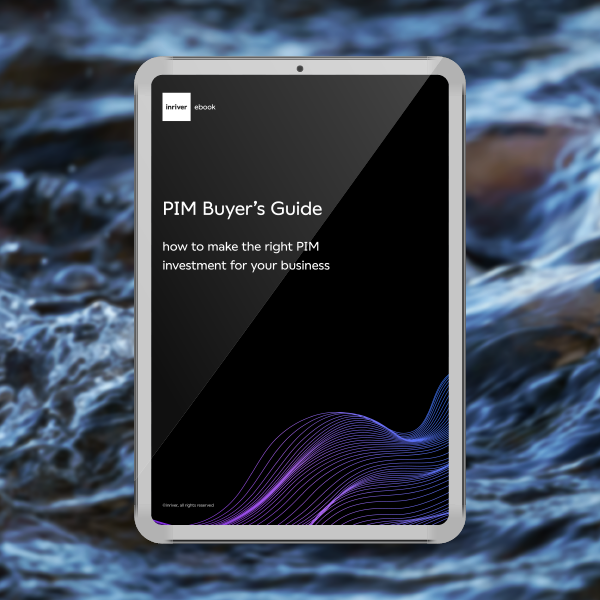What is a PIM database?
Choose the right data solution for you
See the many benefits a robust PIM database can bring to every team in the organization, from sales to compliance and beyond.
Product Information Management (PIM) is a system that centralizes and manages all data related to a company’s products. A PIM database is the foundation of that PIM system, serving as an organization’s central repository for product-related data.
Yet far from a simple data dumping ground, a PIM database is an architectural marvel—or at least, it should be. It’s a strategic hub to facilitate the storing, managing, and retrieving of accurate product data.
In tandem with the right PIM software, a PIM database enables brands, manufacturers, and retailers to transform growing data demands into a tool for genuine growth.
Benefits of a dedicated PIM database
One study by McKinsey found that workers spent nearly 20% of their week simply tracking down information. The reason? Fragmented, outdated, and siloed product data. Rather than slow your team down, a dedicated PIM database unlocks speed and efficiency across your organization by:
- Centralizing information: Consolidate product data into a single source of truth, eliminating data silos and inconsistencies.
- Reducing returns: Reduce the chance of customer returns due to outdated, incorrect, or mismatched product information.
- Improving conversion: Capture customer attention and enhance their experience with high-quality data that boosts conversion rates.
- Accelerating time to market: Facilitate faster product launches by streamlining data collection and distribution.
- Identifying content gaps: Help identify missing or incomplete product content, enabling teams to fill informational gaps more efficiently.
- Managing compliance: Establish an essential structure for compliant data, from security to supply chain traceability.
A dedicated PIM database streamlines these key touchpoints to enhance internal efficiency, customer satisfaction, and market competitiveness.
PIM database vs. traditional databases
Almost any software can store data. The real problem lies in version control and scalability. How can you be sure everyone is looking at the same source of truth if that source of truth is always changing and evolving? If you’re dealing with data in spreadsheets or silos, you can’t.
A PIM platform goes beyond simple storage by serving as the definitive source of data truth across your organization, by way of:
- Flexible data models: Dynamically adaptable PIM data models accommodate diverse product attributes across unlimited channels and the ever-evolving data related to each product.
- Data integration: Multiple data sources come together to enhance consistency and quality throughout the data standardization, validation, and enrichment processes.
- User accessibility: User-friendly interfaces cater to non-technical users, streamlining data retrieval and management across the organization.
In contrast to business databases that rely on rigid data hierarchies, manual updates, and archaic programming, a PIM database is purpose-built for agility and scalability.

Who benefits from a PIM database?
Any team member who deals with product information (read: everyone) can benefit from a PIM database. Here are just a few ways certain teams in your organization can benefit from a PIM platform:
For marketing teams
A PIM database is the ideal platform for creating, managing, enriching, and distributing product content across channels. By establishing a single source of truth, PIM databases ensure marketing teams deliver a unified brand message to every customer.
For sales professionals
Without updated and accurate product information, sales teams have nothing to win with. A PIM database arms salespeople with up-to-the-minute product information, specific benefits, customer reviews, and supporting information. With accurate product catalog information, sales professionals can better meet customer needs.
For IT departments
Modern PIM databases update and scale on a cloud-based infrastructure. This eliminates the need for scheduled maintenance or extensive software overhauls, freeing up IT teams for more pressing projects. They can also manage digital assets more effectively.
For supply chain managers
Delayed procurement and imbalanced inventories continually challenge supply chain managers. But not with a PIM database. Real-time inventory updates and automated systems enable full visibility across every link of the supply chain. This ensures data accuracy and efficient data management across all catalogs.
For compliance
With increasingly stringent sustainability regulations, full data transparency is more important than ever. A PIM database offers absolute and unerring traceability down to the smallest detail, giving the compliance team what they need to keep the business competitive and in good standing.

PIM integration in modern commerce
Where do PIM databases fit in with your existing tech stack? While it requires careful planning and execution, PIM implementation can integrate with almost any existing business infrastructure.
This process involves:
- Mapping out data sources
- Setting up data integration processes
- Training staff on the new system
Global apparel company New Balance felt the benefits of a PIM implementation firsthand. The massive amounts of unstructured data that made up their product profile demanded a robust yet flexible database. With the Inriver PIM solution serving as a single source of data truth, New Balance quickly and efficiently launched new e-commerce websites across Europe, Asia-Pacific, Canada, and the US.
Inriver: The ideal PIM database solution
Managing product information is a complex endeavor. But it’s also an enormous growth opportunity. A PIM database is essential for brands, manufacturers, and retailers seeking to grow their business, improve operations, and command their customer experience.
If your business could benefit from a single source of data truth, consider the Inriver PIM. As a market-leading product information management solution, Inriver excels in ensuring that your product data is accurate, consistent, and primed for distribution across all channels. The Inriver PIM software supports data quality and streamlines operations, making it a vital PIM tool for any enterprise.
want to see the Inriver PIM in action?
Schedule a personalized, guided demo with an Inriver expert today to see how the Inriver PIM can get more value from your product information.
you may also like…
Frequently asked questions
What are the signs that your company needs a PIM database?
Signs include inconsistent product data across channels, high return rates due to inaccurate information, difficulties managing your product data, and/or internal lags in product data efficiency. If you’re still trying to manage your product data through spreadsheets and email, it’s probably time to upgrade to a PIM database.
How do PIM databases integrate with other business tools?
PIM databases can integrate with almost any business tool—including ERP systems, e-commerce platforms, and marketing automation software—through seamless APIs and connectors.
Is PIM an ERP system?
No, PIM is not an ERP system. ERP systems often lack the data structure flexibility to handle complex product details, assets, and relationships. ERP systems are also designed for internal operations, whereas PIM aligns product data for internal and external touchpoints.
What is the difference between PIM and CMS?
A PIM system is designed to manage and distribute product information, while a Content Management System (CMS) focuses on managing and publishing web content. PIM and CMS can work together to create engaging, on-brand digital experiences.
